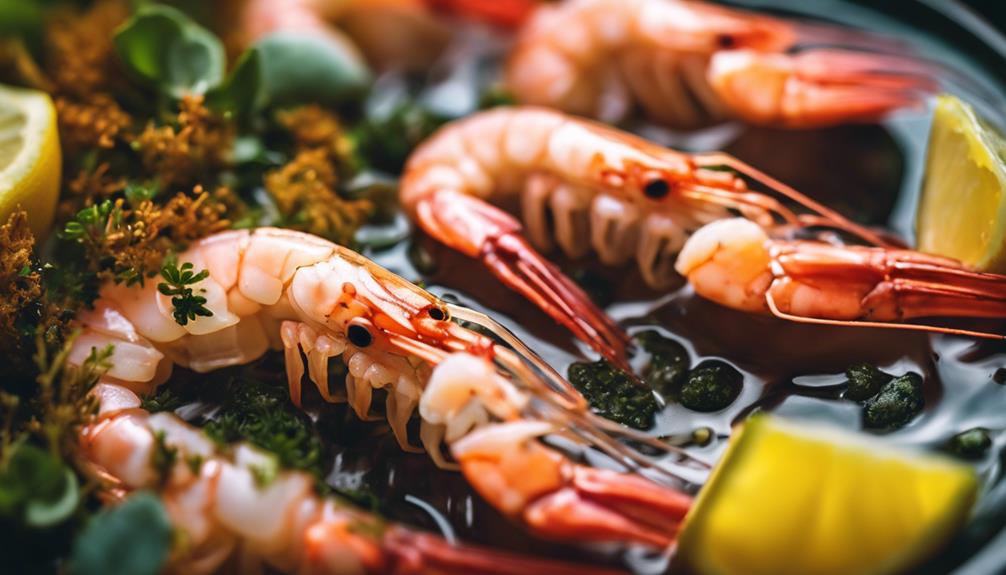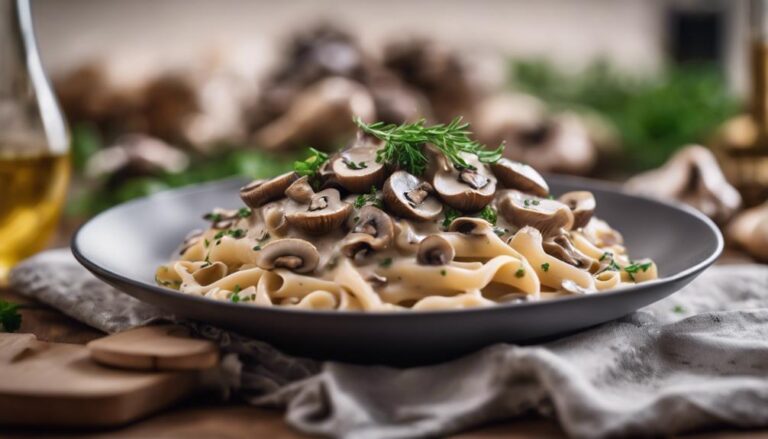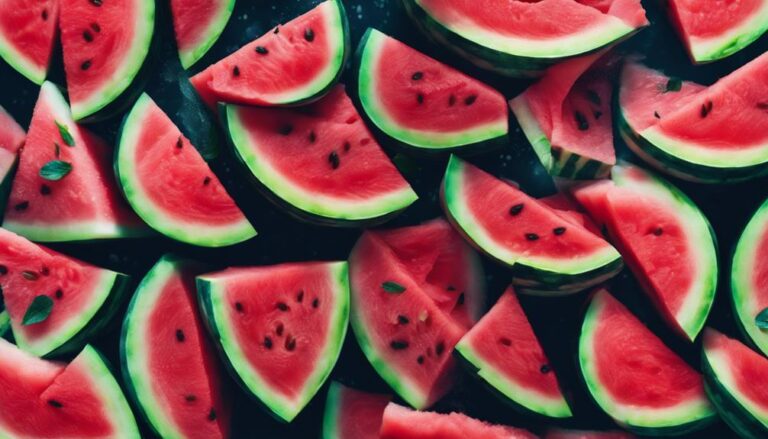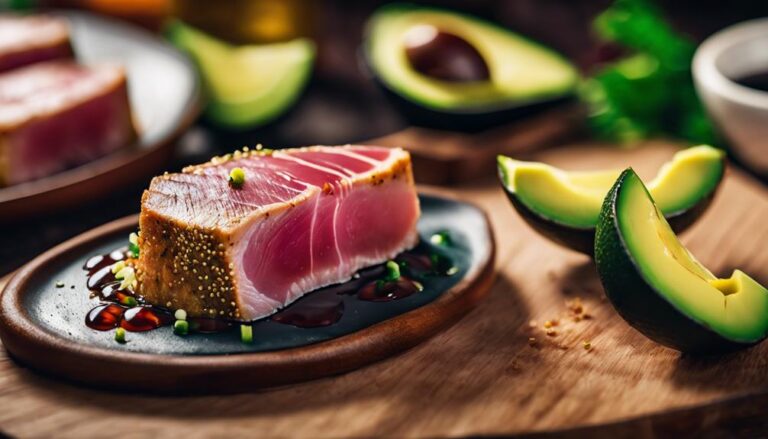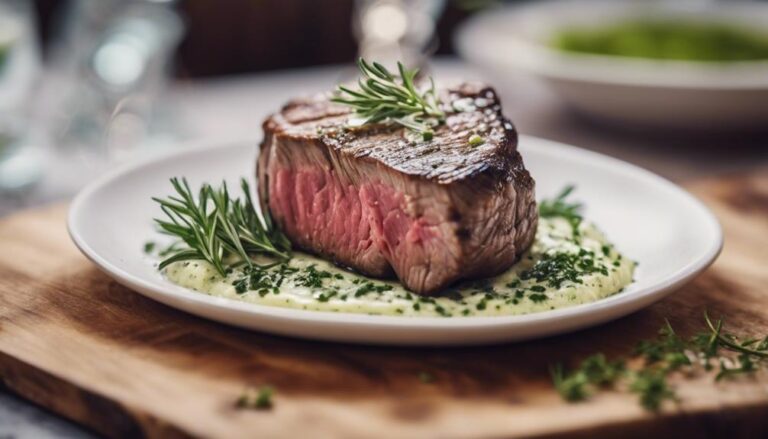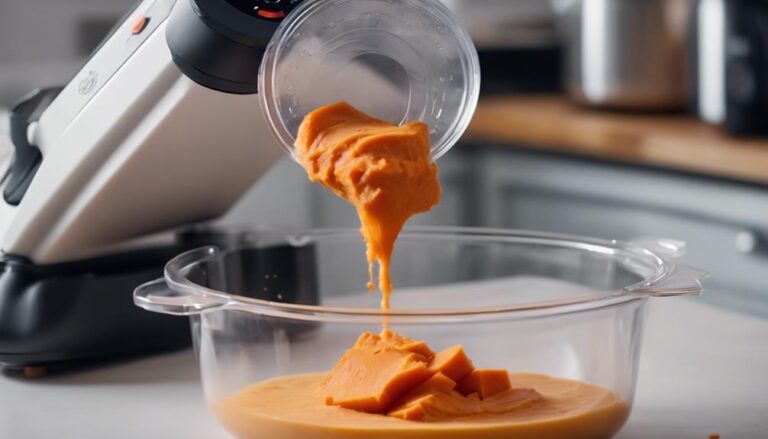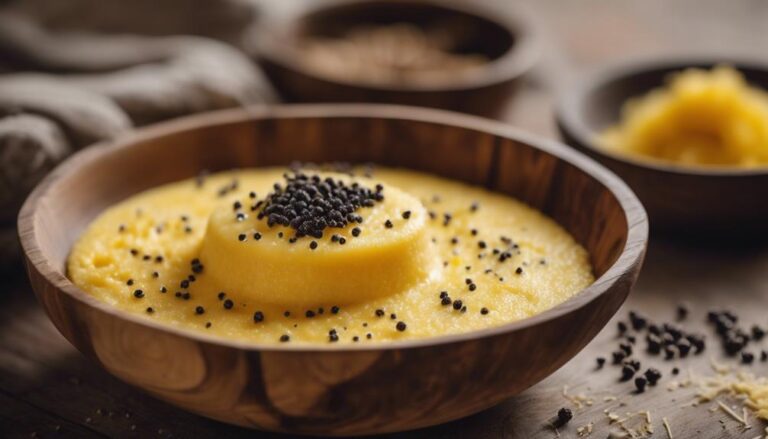Lemon-Garlic Sous Vide Shrimp
Enhance your cooking skills by trying Lemon-Garlic Sous Vide Shrimp. Seal fresh shrimp with lemon and garlic in airtight bags for precise cooking. Set your machine to 135°F for 30 minutes for juicy shrimp. Consistent low temperature is key for perfect texture. The flavors of lemon and garlic infuse the shrimp beautifully. Achieve succulent results with precise timing and temperature control. This dish promises a burst of vibrant flavors that will leave your taste buds delighted. Master this recipe for a delightful culinary experience. Start creating delicious sous vide shrimp now.
What You Will Learn Here
- Sous vide technique ensures precise cooking at 135°F for 30 minutes.
- Fresh shrimp, lemons, and garlic are essential for vibrant flavors.
- Maintaining stable temperature throughout cooking guarantees succulent results.
- Timing ranging from 30 minutes to 1 hour is crucial for desired doneness.
- Easy recipe with minimal ingredients, offering versatility and customization.
Origin of Sous Vide
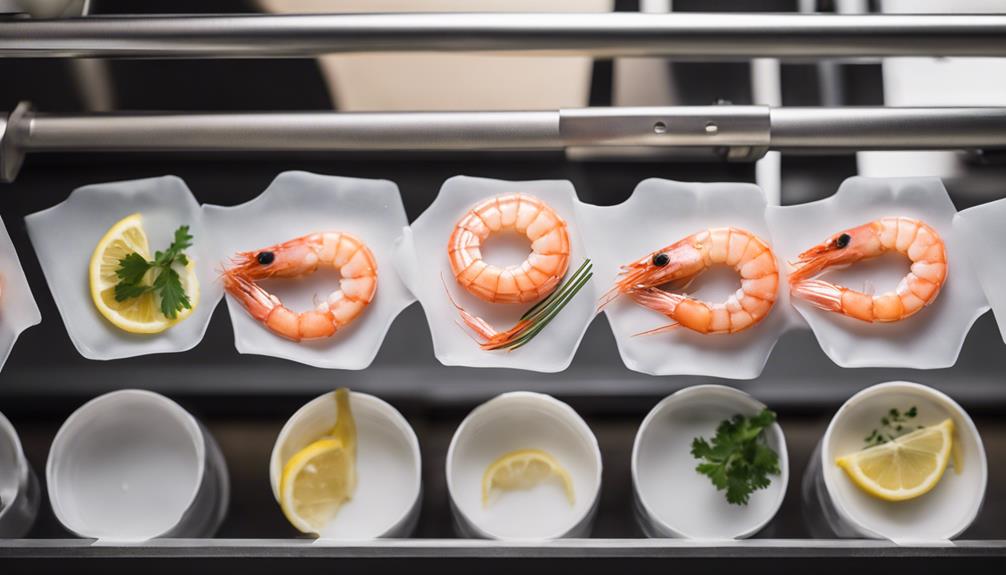
Sous Vide, a culinary technique originating in the 1970s, revolutionized precision cooking.
This method involves sealing food in airtight bags and immersing it in a water bath at a precisely controlled temperature.
Chefs embraced sous vide for its ability to maintain flavors and textures while ensuring consistent results, marking a significant innovation in the culinary world.
Sous Vide Technique
With origins dating back to the late 1960s, the sous vide technique revolutionized the culinary world by introducing a precise method of cooking food in vacuum-sealed bags at consistent low temperatures. This method involves sealing ingredients in a plastic pouch, removing air through a vacuum sealer, and immersing the pouch in a water bath heated to a specific temperature. The controlled environment guarantees that the food cooks evenly and retains its natural flavors, juices, and nutrients.
The sous vide technique provides chefs with unparalleled control over the cooking process, allowing them to achieve precise results that are difficult to replicate using traditional cooking methods. By cooking food at lower temperatures for longer periods, sous vide helps to tenderize tough cuts of meat while preserving their moisture content. This method also enhances flavors as ingredients cook in their own juices, creating a depth of taste that's unique to sous vide preparations.
Culinary Innovation
The culinary innovation that birthed the sous vide technique stemmed from a quest for precision and flavor enhancement in cooking methods. The concept of cooking food in a precisely controlled water bath at low temperatures dates back to the late 18th century. However, it wasn't until the 1960s that French and American engineers collaborated to develop the sous vide method as it's understood today.
Seeking to maintain the natural juices and flavors of ingredients, chefs discovered that vacuum-sealing food in bags and cooking it at precise temperatures produced unparalleled results. This innovative approach revolutionized the culinary world by allowing for consistent doneness throughout the food without the risk of overcooking. The sous vide technique quickly gained popularity in fine dining establishments for its ability to create tender, flavorful dishes with remarkable precision. By understanding the science behind how different temperatures affect various ingredients, chefs could elevate the dining experience to new heights.
Precision Cooking
During the late 18th century, a quest for precision and flavor enhancement in cooking methods led to the development of the revolutionary sous vide technique. Sous vide, which means 'under vacuum' in French, involves cooking food in vacuum-sealed bags at precise temperatures in a water bath. This method allows for consistent heat distribution, ensuring that the food is cooked evenly throughout.
The origin of sous vide can be traced back to Sir Benjamin Thompson, a physicist and inventor, who discovered the principle of thermal conductivity. This discovery laid the foundation for the sous vide method by emphasizing the importance of controlling temperature in cooking.
In the 1960s, sous vide gained popularity when Georges Pralus, a French chef, experimented with the technique to cook foie gras. However, it wasn't until the 1970s that sous vide became more widely recognized thanks to Bruno Goussault, who refined the method and introduced it to top chefs around the world.
Today, sous vide has become a staple in professional kitchens and is increasingly popular among home cooks seeking restaurant-quality results with precision cooking.
Key Ingredients for Flavor
To enhance the taste of your Lemon-Garlic Sous Vide Shrimp, focus on selecting the essential ingredients that pack a flavorful punch. Here are some key ingredients you should consider:
- Fresh Shrimp: Opt for high-quality, fresh shrimp to guarantee a delicious taste. The freshness of the shrimp will greatly impact the overall flavor of your dish.
- Lemons: Freshly squeezed lemon juice adds a zesty and citrusy kick to the shrimp, enhancing its natural flavors. The acidity of the lemon balances the richness of the dish.
- Garlic: Garlic, whether minced or sliced, brings a robust and aromatic element to the shrimp. It infuses the dish with a savory depth that complements the other flavors.
Sous Vide Chicken Breast
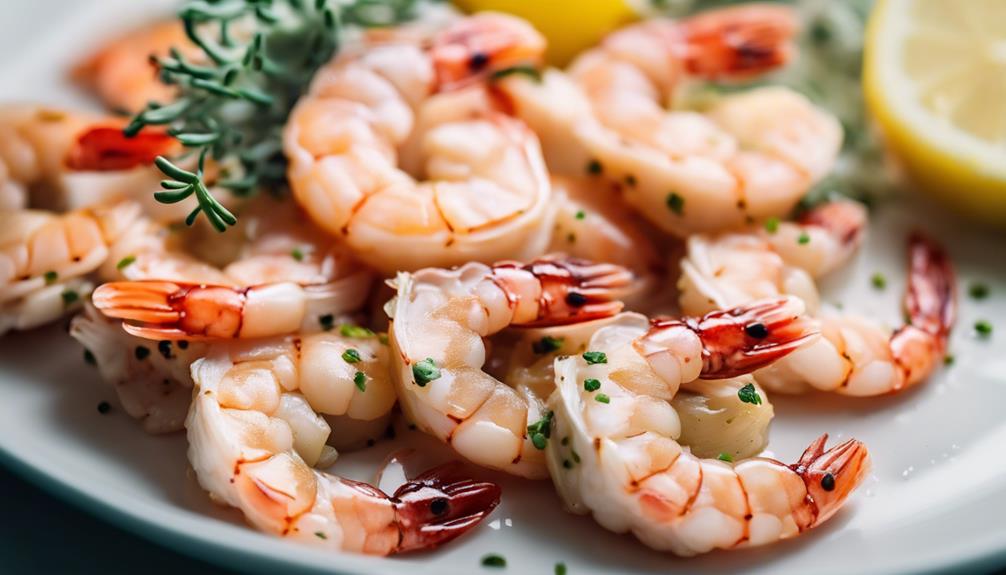
When it comes to sous vide cooking, the ASPECTS worth exploring involve succulent Shrimp Sous Vide, flavorful Sous Vide Pork Chops, and indulgent Garlic-Herb Sous Vide Lobster.
These dishes showcase the versatility and precision that sous vide can bring to your culinary creations.
Experimenting with different proteins and flavors can elevate your cooking game and impress your taste buds.
Succulent Shrimp Sous Vide
To guarantee the most succulent shrimp sous vide, make sure your shrimp are impeccably fresh and deveined before sealing them in the sous vide bag. Here are three essential tips to achieve perfect results:
- Quality Shrimp Selection: Opt for high-quality, fresh shrimp to guarantee the best flavor and texture in your sous vide dish. Look for firm, translucent shrimp with a mild sea smell to indicate freshness.
- Thorough Deveining: Properly devein your shrimp before cooking to enhance the overall taste and presentation. Deveining guarantees the removal of the digestive tract, leading to a cleaner and more enjoyable eating experience.
- Sealing for Precision: When sealing the shrimp in the sous vide bag, ensure there are no air pockets to guarantee even cooking and maximum flavor infusion. Proper sealing maintains the integrity of the shrimp while cooking, resulting in a tender and succulent final product.
Sous Vide Pork Chops
For perfectly cooked sous vide pork chops or tender sous vide chicken breast, precise temperature control is crucial. To achieve the best results, follow these key steps:
- Temperature Precision: Set your sous vide machine to the exact temperature recommended for the type of meat you're cooking. This guarantees that the pork chops or chicken breast are cooked to the desired level of doneness without any guesswork.
- Seasoning: Before vacuum-sealing the meat, season it generously with your favorite herbs and spices. This allows the flavors to infuse into the meat during the sous vide process, resulting in a more delicious final dish.
- Finishing Touch: After sous vide cooking, quickly sear the pork chops or chicken breast in a hot pan to create a beautiful crust on the outside while keeping the inside perfectly tender and juicy. This final step adds texture and depth of flavor to your dish, making it restaurant-quality.
Garlic-Herb Sous Vide Lobster
After mastering the precision of temperature control for your sous vide pork chops or chicken breast, elevate your culinary skills with a flavorful and tender Garlic-Herb Sous Vide Lobster. This delicious dish will impress your guests and leave them craving more.
Here's how to prepare this exquisite meal:
- Ingredients:
- Fresh lobster tails
- Garlic cloves
- Fresh herbs (such as parsley, thyme, or chives)
- Butter
- Preparation:
- Season the lobster tails with salt and pepper.
- Place the lobster tails, garlic cloves, fresh herbs, and a pat of butter in a vacuum-sealed bag.
- Seal the bag using a vacuum sealer to guarantee proper cooking.
- Cooking:
- Set your sous vide machine to the desired temperature for lobster (typically around 140°F).
- Cook the lobster tails in the water bath for 45-60 minutes.
- Once done, sear the lobster tails in a hot pan for a golden finish.
Enjoy the succulent Garlic-Herb Sous Vide Lobster, a dish that will no doubt leave a lasting impression on your taste buds.
Sous Vide Time and Temperature
When preparing sous vide shrimp, remember that the ideal cooking conditions are essential for succulent results. Precision in time and temperature is key to achieving perfection in your dish.
Keep in mind that timing plays a critical role in sous vide cooking, so follow the recommended guidelines closely for the best outcome.
Optimal Cooking Conditions
To guarantee flawlessly cooked Lemon-Garlic Sous Vide Shrimp, maintain precise control over the time and temperature settings during the sous vide process. Setting the sous vide machine to 135°F (57°C) for 30 minutes ensures a tender and juicy texture while preserving the shrimp's natural flavors. This temperature strikes the perfect balance between cooking the shrimp thoroughly and retaining its delicate taste.
Be mindful not to exceed this temperature to prevent the shrimp from becoming rubbery or overcooked. Likewise, adjusting the cooking time longer than 30 minutes risks compromising the shrimp's tenderness. Consistency is key; ensure that the temperature remains stable throughout the cooking duration.
Precision for Perfect Results
For consistently perfect results in sous vide cooking, precision in setting the time and temperature is vital. Sous vide cooking relies on maintaining precise control over the cooking environment to achieve the desired outcome. When preparing lemon-garlic sous vide shrimp, the recommended temperature is around 135°F (57°C) for a tender and succulent texture. This temperature allows the shrimp to cook gently and evenly without becoming tough or rubbery.
Timing plays an essential role in sous vide cooking. The cooking time for shrimp typically ranges from 30 minutes to 1 hour, depending on the size of the shrimp and your desired doneness. It's important to follow a reliable sous vide shrimp recipe to make sure that you achieve the perfect balance of flavors and textures.
Timing Is Critical
Achieving precise timing in sous vide cooking is vital for excellent results. When cooking shrimp sous vide, the temperature and time are key factors. For perfectly tender shrimp, set your sous vide water bath to 135°F (57°C) and cook the shrimp for 30 minutes. This exact timing guarantees that the shrimp are cooked through while remaining juicy and flavorful.
If you prefer your shrimp a little firmer, you can increase the temperature to 140°F (60°C) and cook them for 15 minutes. Keep in mind that timing can vary depending on the size of the shrimp, so it's important to adjust accordingly.
On the other hand, if you like your shrimp extra tender, you can lower the temperature to 130°F (54°C) and cook them for 45 minutes. This longer cooking time allows the shrimp to reach the desired texture without becoming tough.
Final Thoughts
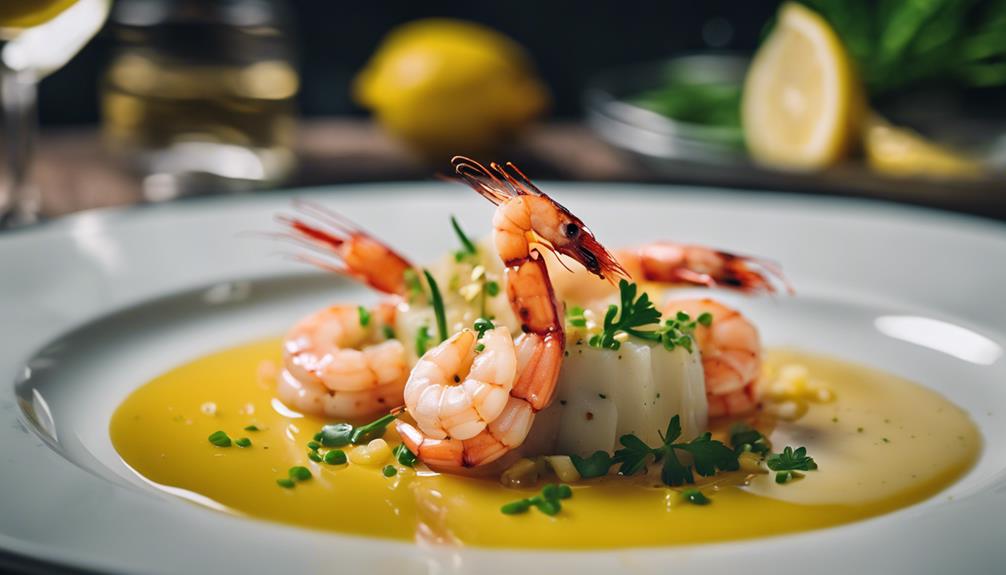
Considering the overall flavor profile and ease of preparation, Lemon-Garlic Sous Vide Shrimp is a delightful dish worth adding to your cooking repertoire. The combination of zesty lemon and savory garlic infuses the shrimp with a burst of vibrant flavors that are sure to impress your taste buds. The sous vide method guarantees that the shrimp is perfectly cooked to tender and juicy perfection, making it a standout dish for any occasion.
One of the key advantages of this recipe is its simplicity. With just a handful of ingredients and minimal prep work, you can create a restaurant-quality dish right in your own kitchen. The precise temperature control of the sous vide technique ensures consistent results every time, taking the guesswork out of cooking shrimp to perfection.
Furthermore, the versatility of Lemon-Garlic Sous Vide Shrimp allows for easy customization to suit your preferences. Whether you prefer a hint of spice with added red pepper flakes or a touch of freshness with chopped parsley, you can tailor this dish to cater to your individual taste.
Frequently Asked Questions
Can Sous Vide Cooking Be Used for Vegetables and Fruits?
Yes, sous vide cooking can be used for vegetables and fruits. It's a versatile method that helps retain nutrients and flavors. You'll love the results – perfectly cooked produce with enhanced taste and texture.
Is It Possible to Sous Vide Frozen Shrimp Directly?
Yes, you can sous vide frozen shrimp directly. Simply make sure they are properly sealed to prevent water from getting in. Adjust cooking time slightly to account for the frozen state. Enjoy the convenience!
Can Different Types of Citrus Be Used Instead of Lemon?
Yes, you can use a variety of citrus fruits like lime, orange, or grapefruit instead of lemon for a unique twist in your recipe. Experiment with different flavors to find your favorite combination.
What Are the Best Side Dishes to Pair With Sous Vide Shrimp?
Pair your sous vide shrimp with light and fresh sides like a green salad with citrus vinaigrette, quinoa pilaf, or roasted asparagus. These dishes complement the shrimp's delicate flavors and bring a balanced meal together.
Are There Any Safety Concerns With Cooking Shrimp Sous Vide Style?
When cooking shrimp sous vide, maintain proper food safety. Be cautious about time and temperature to prevent bacterial growth. Follow recommended guidelines, like using pasteurized shrimp, maintaining precise cooking conditions, and promptly cooling leftovers.
Conclusion
To sum up, sous vide cooking offers a precise and efficient method for creating tender and flavorful dishes like lemon-garlic shrimp. By sealing the ingredients in a vacuum-sealed bag and cooking them in a water bath at a controlled temperature, you can achieve consistent results every time.
Experiment with different seasonings and cooking times to customize your dish to your taste preferences. Sous vide is a versatile technique that can elevate your culinary skills and impress your guests.
Happy cooking!
